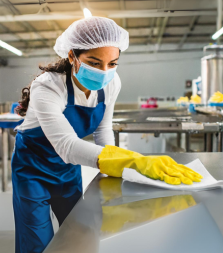Last Updated DECEMBER 2024
Master hygiene protocols to drive efficiency in your food processing facility
Confidence & compliance: cultivating a culture of cleanliness for operational excellence

Safeguard your production, streamline operations
In today's transparency-driven food industry, every production step matters. But the foundation of quality often lies unseen – within the meticulously controlled environment where ingredients embark on their journey. Here, pristine conditions aren't just a dream, they're a strategic necessity. Let’s dive a little deeper into key considerations for food production cleanliness, the cornerstone of both product safety and operational excellence.
Why traditional cleaning isn't enough?
Traditional cleaning methods often fall short against unseen threats. Inadequate spill control can lead to downtime and contamination risks. Additionally, cross-contamination concerns and inefficient waste management strategies can significantly impact your bottom line.
Wet and dry cleaning techniques in the food industry
In the food and beverage industry, cleaning operations can be categorized into two primary methods:

Dry cleaning:
Ideal for environments with low moisture, such as:
• Grain and cereal processing
• Dry blending facilities
• Dry storage areas
• Warehouses

Wet cleaning:
The primary method for most facilities, focusing on thorough sanitation. Includes a sequence of essential steps:
• Pre-rinsing to remove loose debris
• Chemical washing to eradicate contaminants
• Post-rinsing to clear residual chemicals
• Sanitizing to ensure surfaces and equipment are hygienic
While some facilities might need both wet and dry cleaning approaches depending on their specific requirements, the above steps provide a robust framework for maintaining high standards of cleanliness in food processing environments. To ensure comprehensive cleanliness in a food processing factory, it's essential to focus on specific stations and incorporate data-driven cleaning practices.
Here are key areas along with specific practices and protocols:
Receiving Area: This is where raw materials are introduced into the factory. It's crucial to inspect all incoming materials for contamination and cleanliness before they enter the processing area. Implement strict cleaning protocols after each delivery to remove debris and potential contaminants.
Processing Area:This is the core area where food is handled and processed. Regular cleaning every 2-4 hours, depending on the operation intensity, is necessary. Surfaces should be sanitized with food-grade chemicals that reduce microbial counts.
Packaging Area: Packaging materials should be kept in a clean environment to prevent contamination of the packaged goods. Surfaces in contact with food should be cleaned and sanitized at least once every shift or more frequently based on activity.
Storage Area: Ensure that storage shelves are cleaned weekly and checked for signs of pests. Foods should be stored off the floor and properly sealed to prevent contamination.
Waste Disposal Area: Regularly clean and sanitize bins and the surrounding area to prevent odors and pest attraction. Implement a daily cleaning schedule for this area.
Employee Facilities: Restrooms, changing rooms, and break rooms should be cleaned at least twice a day. Sanitation stations should be available, encouraging employees to maintain personal hygiene.
Quality Control Lab: This sensitive area requires daily cleaning and sterilization of equipment to prevent cross-contamination of samples used for microbial and quality testing.
Addressing the challenges: a multifaceted approach
Many sanitisation methods are ineffective if there is food or detergents present. There are six phases to the sanitisation process. These are:
• Pre Wash – preparing surfaces for process
• Sweeping – removing loose debris
• Foaming – applying cleaning solution
• Scrubbing – manual scrubbing of all equipment
• Washing – rinsing away cleaning solution
• Sanitising – applying final sanitisation solution
The sanitisation process required in food processing facilities is substantially different than that of a regular commercial clean to ensure hygiene standards are met. Each plant is different, so it’s also important to ensure that the cleaning process is tailored to your facility.
Elevate your food processing standards with our essential cleaning guide.

Optimise hygiene and efficiency
Resources:
https://www.fpe.net.au/cleaning-in-food-processing-industry/
https://blog.foodsafedrains.com/4-steps-to-improve-food-processing-plant-hygiene
https://www.nsf.org/knowledge-library/clean-food-processing-facilities


















